Sharing means caring!
Vintage Christmas decorations continue to grow in popularity, especially antique Christmas tree ornaments. The holiday season is the perfect time for nostalgia, and vintage decor can add a special touch of charm and whimsy to your home.
If you’re looking to start your own vintage Christmas decorations collection, I have some tips and history to share with you today that can help you get started.

A Brief History of Antique Glass Christmas Tree Ornaments
The first glass tree ornaments were made in Germany in the mid-19th century. There were two main types of glass decorations – heavy blown glass designs called kugels and mass-produced thin glass decorations. The thinner type was produced primarily using mercury glass, which is thin glass coated on the inside with a mixture of mercury and tin.
Beginning in the 1870s, the famous American retailer F. W. Woolworth began importing mercury glass ornaments into the United States, where sales steadily grew. Max Eckardt, a German immigrant to the United States, also noticed this growing trend and founded his glass decorating company, Shiny Brite, in 1937.
Shiny Brite reigned as the king of American-made glass ornaments throughout the 1930s, 1940s, and 1950s. During the 1960s, plastic ornaments began to increase in popularity and production of Shiny Brites began to decline.
In 2001, designer Christmas Radko purchased the Shiny Brite brand, and began reproducing some of the most classic designs.
You can always tell Shiny Brite because the name will be stamped on the metal decoration cap.
Balls are the most common design, but you can also find glitter balls shaped like bells, tear drops, and other quirky shapes. This gorgeous collection of Shiny Brites is currently available in my online store.

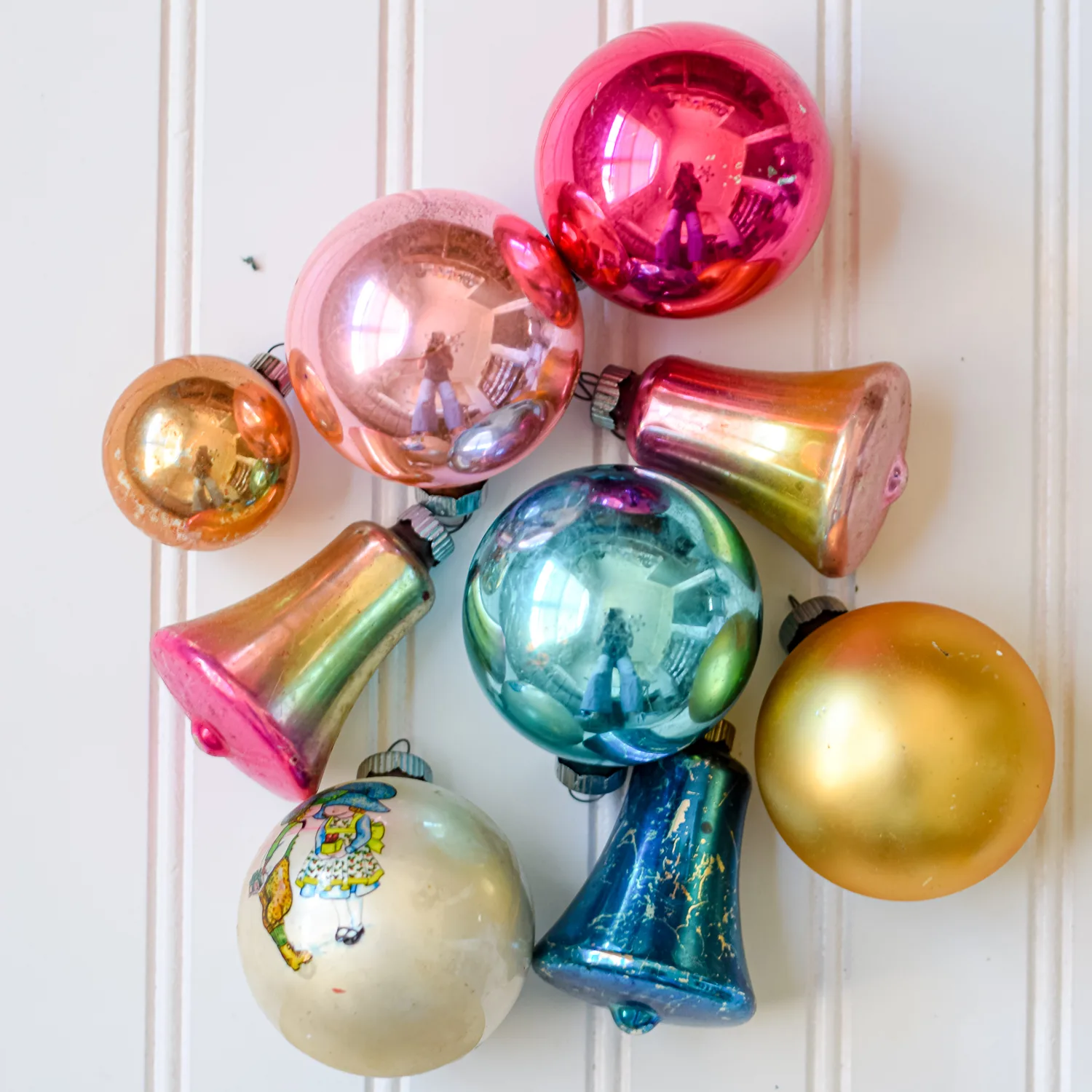
You can find a more detailed history of Shiny Brite here in this great article by Antique Trader.
Other vintage glass Christmas ornaments
Kugels
I mentioned kugels earlier, they are another great group to start with. The word “kugel” translated from German means “ball” or “ball”, so all blown glass ornaments were called kugels – not necessarily the name of a specific company.
These types of jewelry are distinguished by the thickness of their glass. You can often find it in the form of grapes, apples, and drops, as well as the regular ball. They will also have a decorative metal cover in brass or bronze.

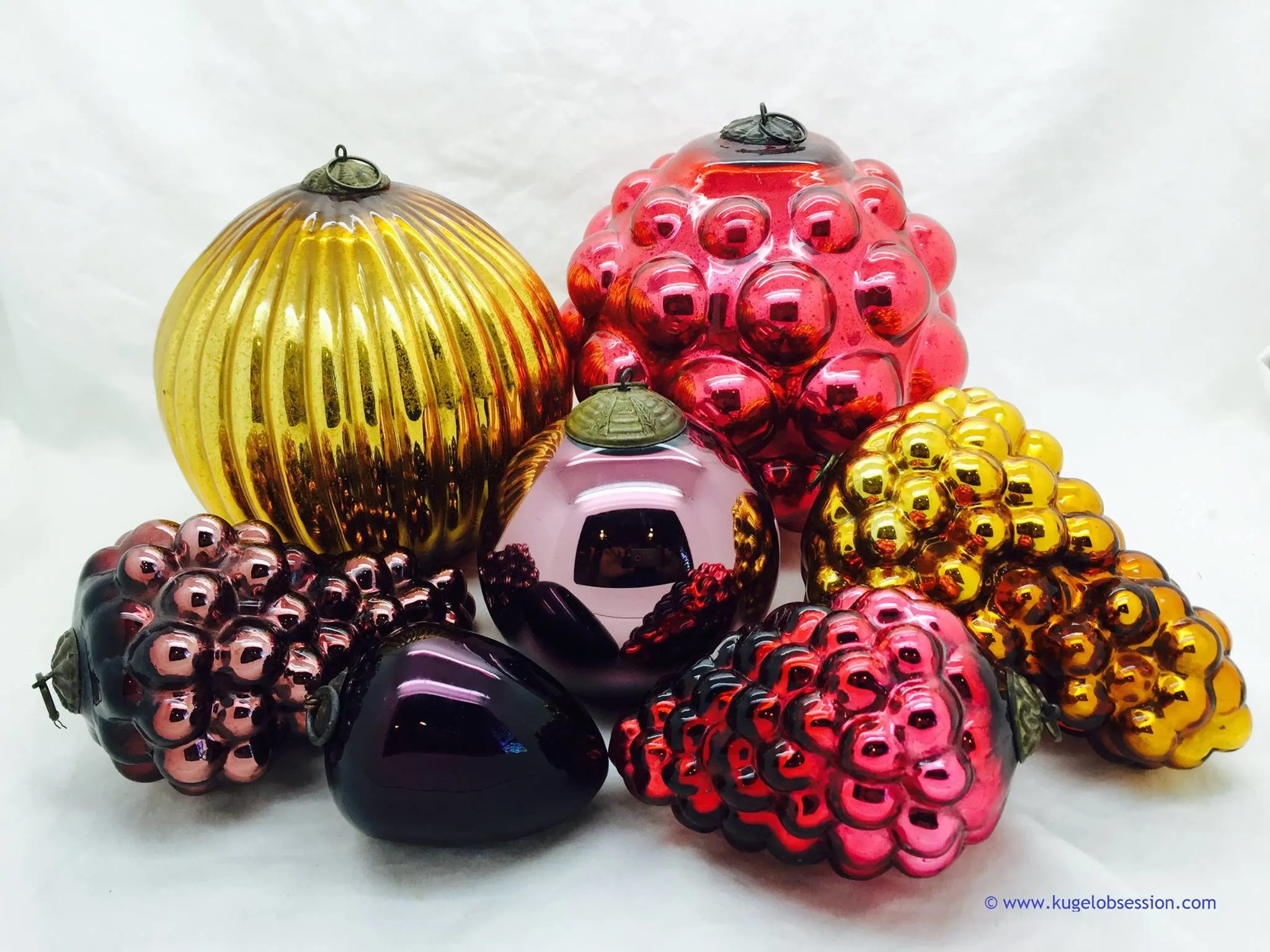
From Kugel Obsession on Facebook
In recent decades, Kugel copies have been made all over the world. This article here can be very helpful in determining whether a kugel is an original hand-blown German piece, or a later copy.
I was lucky enough to find a kugel ornament last Christmas in a thrift store grab bag! It’s a treasure that I now hang on my tree with the rest of my ornament collection.
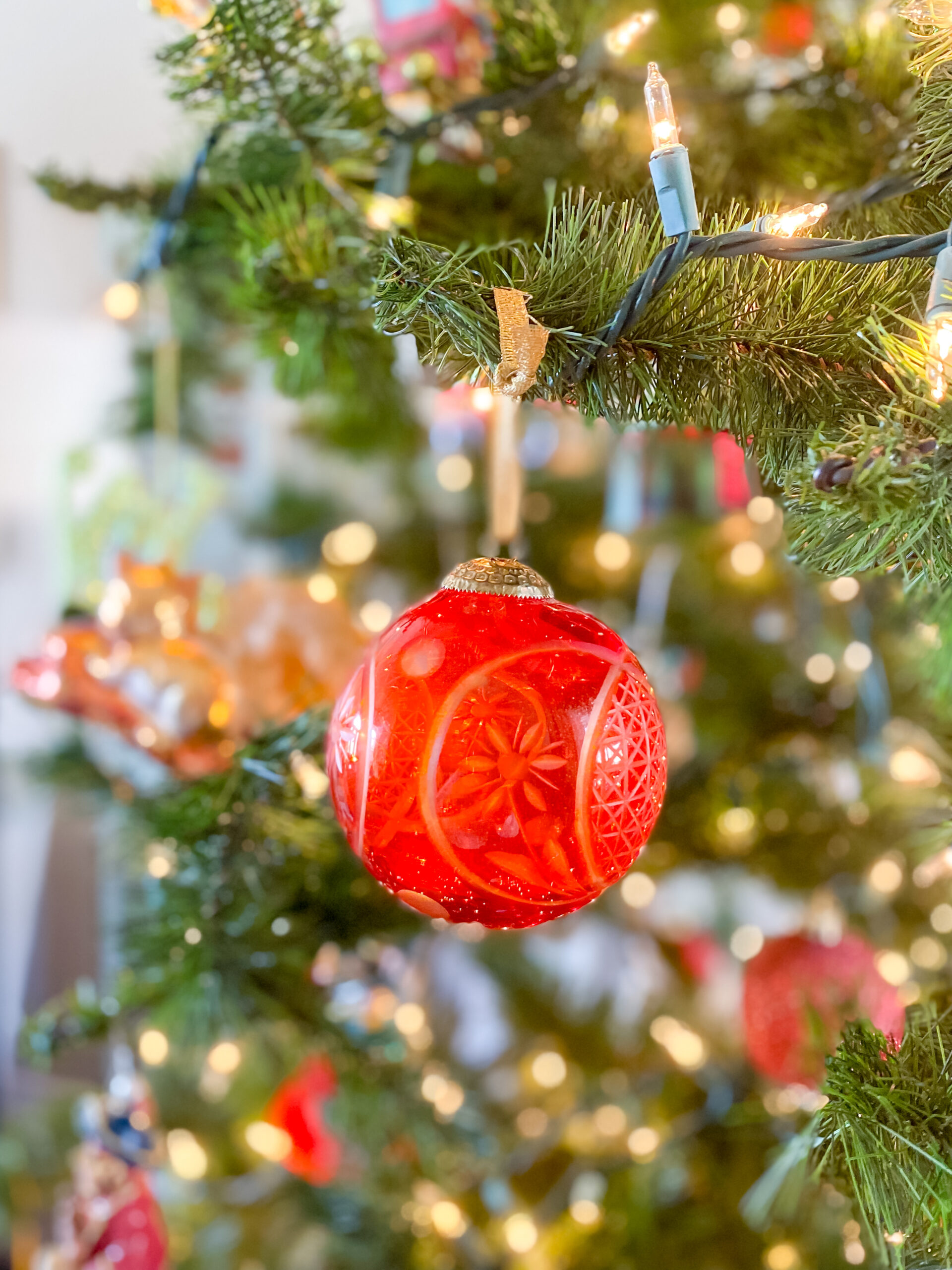

Other mercury glass ornaments
Not all delicate mercury glass ornaments were made by Shiny Brite. Santaland is another famous company that produced ornaments in the United States during the 1960s and 1970s.


In this vintage Santaland box, I actually found a mix of ornaments made by Shiny Brite and other makers dating back to the 1930s.


Marked “Made in USof A”, dated 1938-1942.




The glass decorations were produced in West Germany, most likely in the late 1040s or 1050s
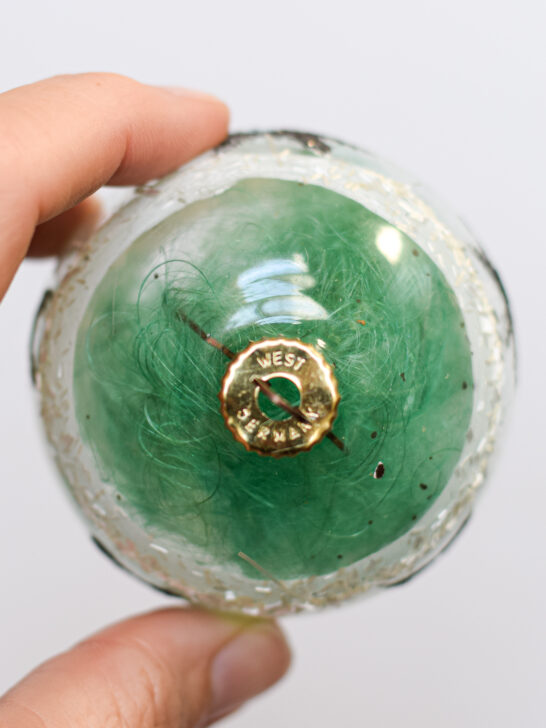



Shiny Brite, probably from the 1940s


This gorgeous set of 6 vintage ornaments with box is on sale in my online store! This will be a great start to your antique glass ornament collection.
I also found this set of antique icy swirl glass ornaments, made in the 1970s. These were likely made by Rauch out of North Carolina.


Vintage wooden Christmas tree ornaments
Wooden ornaments also became popular during the 1970s. These were small figures produced in mostly primary colours, some resembling Alpine figures and locations.
Initially it was produced in Germany, but over time the production regions began to differ. I have some newer products in my own collection that probably date back to the 80’s and have a “Made in Hong Kong” label.

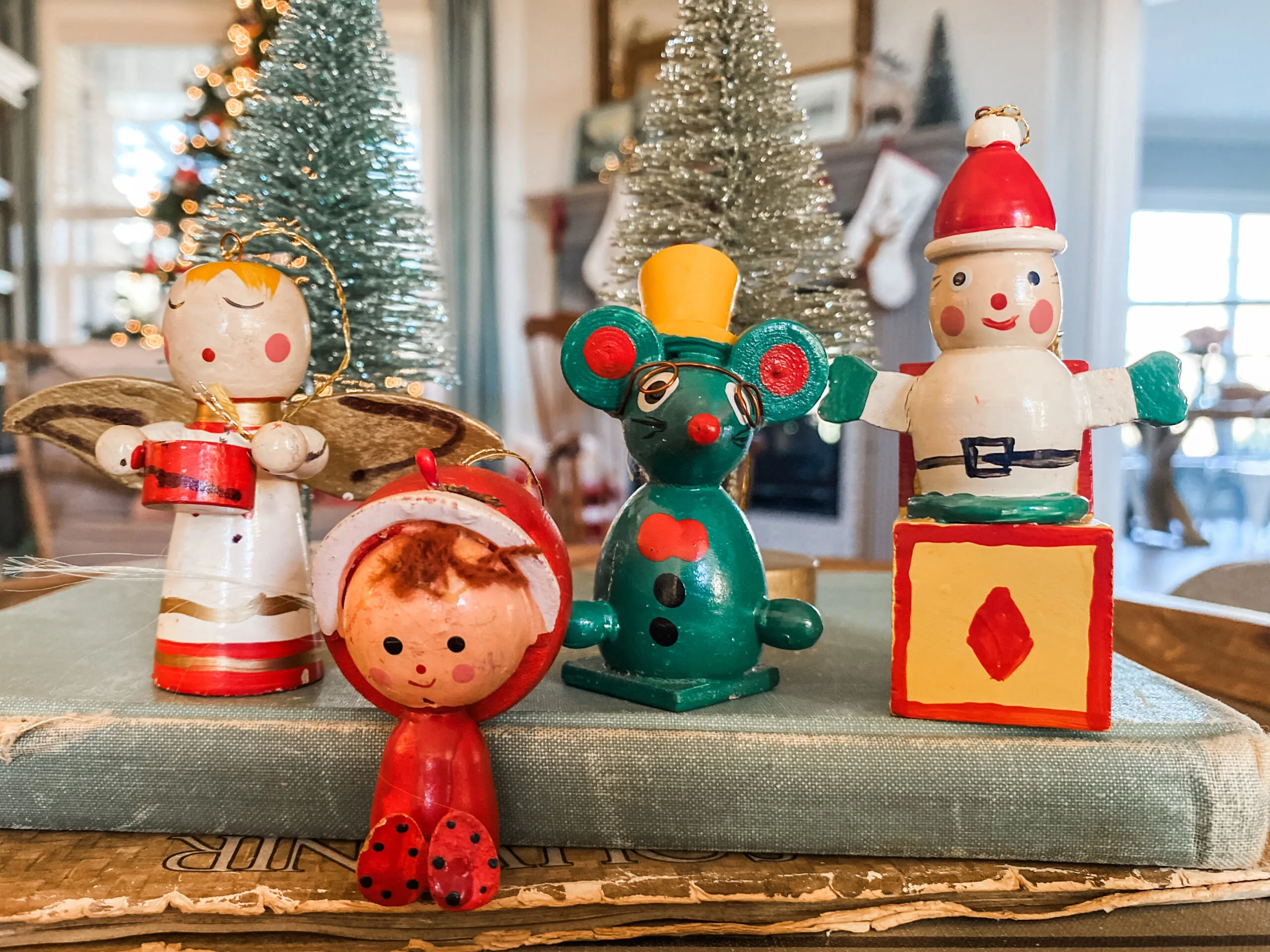
Many of these types of ornaments were made by the B. Shackman novelty store in New York City. If you can find some in the original Shackman case or with a sticker, they may be worth more.
With these decorations, you’ll see lots of animals, toy soldiers, Santa Claus, rocking horses, little huts, angels, bells, and trees.
Because wood is stronger than glass, many of these ornaments have survived, so their prices are slightly lower than their glass counterparts.
I have a set that my grandmother gave me, and we use it for our “baby tree” in the kitchen.


Where do you find antique Christmas decorations?
The first antique jewelry I owned were from my grandmother! So this is a great place to start – ask your family members if they have any old decorations they are willing to part with.
Estate sales are another great option for finding vintage, and sometimes even stolen, ornaments. However, in my experience, they tend to go on sale quickly, so if you see some ads for them in a sale, get there early for the best chance of purchasing.
Thrift stores have not been the best places for me to get glass ornaments, mainly because they usually don’t survive the donation and handling process at those places.
I’ve seen bags of glass ornaments sitting on a shelf before where two-thirds of them were already broken. However, I have been able to find antique wood ornaments at thrift stores, and they are often in plentiful supply.
If there are specific antique ornaments you are looking for and you don’t have time to search estate sales or thrift stores, you can shop with an antique dealer who has done the hard work for you!
I currently have a selection in my online store and also in my booth space for local customers.
Shop all my holiday items here >>>
Etsy is also another great place to find quality vintage ornaments. Here are some of my current favorite lists:
How to decorate with antique Christmas ornaments
Of course, decorating your tree with a gorgeous collection of antique glass ornaments is the most obvious way you can use your collection to decorate.


Image credit Oh Happy Day
Trees decorated with a colorful array of antique glass ornaments form a whimsical decor scheme that recalls holidays past.
You can also take a collection of old ornaments and create a stunning wreath.


Image source: Etsy
Here’s another example I saw recently at a local craft fair.


In case you’re wondering, I wouldn’t suggest hanging a wreath like this on your front door or anywhere that will be exposed to the outside elements or a lot of movement.
Instead, choose a beautiful table to display it on with a wreath stand or perhaps on top of your mantle, so that delicate ornaments can be avoided from getting damaged.
Of course it takes a lot of decorations to fill an entire tree or make a wreath like the ones above. So, if you’re just starting to build your collection and only have a few decorations, you can display them in other ways.
This is a project I do every year, I call it “Christmas in a Box”.


It’s a simple display idea that you can customize with what you have in your home! Simply take a vintage container, place a vase or jar inside and fill it with candy, then add decorations and greenery to fill the rest of the space.
Another cute idea is to open up an old suitcase or suitcase, display it open, and fill it with decorations.


Image via Pinterest
I think this would look cute on an entry table with some greenery around the base, and some holiday artwork stacked behind it.
Wrapping up thoughts on starting your own vintage ornaments collection
It’s easy to start with a collection of vintage Christmas ornaments. Because of its small size, it’s easy to store your collection for the rest of the year without taking up too much space.
They’re also plentiful, whether you look for them yourself at thrift stores or enjoy shopping with an antiques dealer who has already curated a collection.
Whether you make a batch large enough to decorate an entire tree or have a few to share in a pretty glass jar, they add sparkle and shine to your holiday decor. Antique ornaments, paired with some of the glow of twinkle lights, will help create a magical scene for your holiday home.
I hope you start collecting this season!


